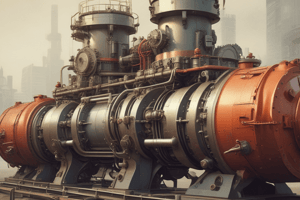Podcast
Questions and Answers
What type of pump uses a flexible tube squeezed progressively by a roller to move fluid?
What type of pump uses a flexible tube squeezed progressively by a roller to move fluid?
- Centrifugal pump
- Peristaltic pump (correct)
- Progressive cavity pump
- Axial flow pump
Which type of pump is suitable for pumping sludge, abrasive liquids, and industrial chemicals?
Which type of pump is suitable for pumping sludge, abrasive liquids, and industrial chemicals?
- Mixed flow pump
- Centrifugal pump
- Progressive cavity pump (correct)
- Axial flow pump
What characteristic distinguishes dynamic (roto-dynamic) pumps from positive displacement pumps?
What characteristic distinguishes dynamic (roto-dynamic) pumps from positive displacement pumps?
- They move a specific amount of liquid regardless of pump head.
- They do not have suction or discharge check valves.
- They add energy continuously. (correct)
- They have a single helical stainless steel rotor mounted within an elastomer-lined stator.
In which type of centrifugal pump does the liquid enter the centre of the impeller and exit perpendicular to the pump shaft in a radial direction?
In which type of centrifugal pump does the liquid enter the centre of the impeller and exit perpendicular to the pump shaft in a radial direction?
What is the key feature of axial flow pumps?
What is the key feature of axial flow pumps?
What does a centrifugal pump's capacity change with?
What does a centrifugal pump's capacity change with?
What is the main characteristic of a positive displacement pump?
What is the main characteristic of a positive displacement pump?
How do positive displacement pumps differ from dynamic pumps?
How do positive displacement pumps differ from dynamic pumps?
What causes the discharge pressure to pulsate in positive displacement pumps?
What causes the discharge pressure to pulsate in positive displacement pumps?
Which types of pumps are reciprocating pumps classified under?
Which types of pumps are reciprocating pumps classified under?
What creates voids in reciprocating pumps?
What creates voids in reciprocating pumps?
What causes the movement of liquid into the low-pressure void of a reciprocating pump?
What causes the movement of liquid into the low-pressure void of a reciprocating pump?
What will happen if a centrifugal pump is run for extended periods with its discharge valve shut?
What will happen if a centrifugal pump is run for extended periods with its discharge valve shut?
What is the consequence of throttling or closing the suction valve of a centrifugal pump?
What is the consequence of throttling or closing the suction valve of a centrifugal pump?
Why are large centrifugal pumps started with a closed discharge valve?
Why are large centrifugal pumps started with a closed discharge valve?
What is the main consequence of cavitation in a centrifugal pump?
What is the main consequence of cavitation in a centrifugal pump?
What is the characteristic feature of a regenerative (turbine) pump?
What is the characteristic feature of a regenerative (turbine) pump?
Why must a regenerative (turbine) pump always have flow through it at all times?
Why must a regenerative (turbine) pump always have flow through it at all times?
What happens when bubbles formed due to cavitation collapse on the surface of the impeller?
What happens when bubbles formed due to cavitation collapse on the surface of the impeller?
What type of pump uses a flexible diaphragm to increase and decrease the size of the void?
What type of pump uses a flexible diaphragm to increase and decrease the size of the void?
Which type of pump delivers high pressure liquid without the pulsations that occur in reciprocating pumps?
Which type of pump delivers high pressure liquid without the pulsations that occur in reciprocating pumps?
In a double-acting pump, when is the fluid moved?
In a double-acting pump, when is the fluid moved?
What distinguishes a diaphragm pump from a plunger or piston pump?
What distinguishes a diaphragm pump from a plunger or piston pump?
What are the two variations of rotary pumps mentioned in the text?
What are the two variations of rotary pumps mentioned in the text?
Which type of reciprocating pump has a larger capacity than the plunger-style pump?
Which type of reciprocating pump has a larger capacity than the plunger-style pump?




